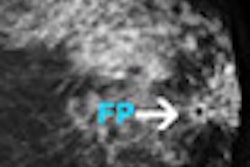Routine screening for osteoporosis in men 65 years and older who have sustained clinical fractures wouldn't place an undue financial burden on the healthcare system, and the same holds true for even older men (80-plus) without a fracture history, according to a study released today in the Journal of the American Medical Association.
Osteoporotic fractures are common among elderly men, but at present only two professional societies [the International Society for Clinical Densitometry (ISCD) and the Canadian Osteoporosis Society] recommend dual-energy x-ray absorptiometry (DEXA) screening for men older than 65, wrote Dr. John Schousboe and colleagues. Annual screening for women age 64 and older is recommended by the U.S. Preventive Services Task Force, and has become a standard part of women's health programs.
"Among men, increased age is associated not only with increased prevalence of osteoporosis and fractures rates but also with increased mortality...despite the importance of the problem...clinical decision making is hampered by a lack of evidence-based cost-effectiveness analyses," wrote Schousboe, a rheumatologist from Park Nicollet Health Services in Minneapolis. His co-authors are from various institutions in Minnesota, California, and Oregon (JAMA, August 8, 2007, Vol. 298:6, pp. 629-637).
The group conducted a modeling study to estimate the lifetime costs and health benefits of bone densitometry screening plus treatment with oral bisphosphonate therapy in men with osteoporosis (femoral neck T-score of less than or equal to 2.5). They used a Markov cost-utility model and included multiple health states such as no fracture, post-clinical vertebral fracture, post-radiographic vertebral fracture, and post-hip fracture.
Fracture probabilities were established as functions of age, presence of osteoporosis, presence or absence of prior clinical fracture, and presence or absence of oral bisphosphonate therapy (alendronate).
Data from the U.S. Third National Health and Nutritional Examination Survey was used to gauge the prevalence of osteoporosis in white males. The investigators factored in direct costs (price of oral biphosphonate, cost of one physician visit) and indirect costs such as loss of productivity.
According to the results, the model estimated that 62% of 50-year-old men were at risk for hip fracture during their remaining lifetime. For 65-year-old men, the estimated prevalence of femoral neck osteoporosis was 14.5%. For 85-year-old men, it was 33.6%. However, if the person did not have a previous clinical fracture, the prevalence was significantly lower: 7.6% for a 65-year-old and 17.6% for an 85-year-old.
"The densitometry and treatment strategy modestly reduced the absolute 10-year incidence of clinical fractures by a range of 2.1% for 65-year-old men with a prior fracture to 4.5% among 85-year-old men with a prior fracture," the authors wrote.
The costs per quality-adjusted life year (QALY) gained were less than $50,000 for those with a prior clinical fracture at all ages and $50,000 among men aged 80-85 years without a prior fracture history. Finally, the maximum gain in life-years was 2.5 days.
In an interview with AuntMinnie.com, Schousboe explained the significance of that gain.
"It is a very small number," he acknowledged. "The reason for that is that the gain you get in preventing fractures is primarily in maintaining the quality of life rather than actual extension of life...the reason why (fractures) are such a problem is not so much because they shorten life, but because of chronic pain and loss of mobility, the quality of life is compromised."
Overall, the study authors came to the following conclusions:
- For osteoporotic men aged 65 years and older with a history of clinical fracture, DEXA followed by therapy may be cost-effective
- For men 80 and older who have no prior fracture or fracture risk factors, screening may also be cost-effective
Finally, cost-effectiveness of DEXA and treatment strategies will increase with a man's age as his risk factors increase as well. Because the patent protection on alendronate runs out in 2008, the cost should come down, they said. The study used the 2004 wholesale price of oral alendronate, which was $1,000 a year.
Schousboe and several of the study co-authors serve as consultants for pharmaceutical manufacturer Merck & Co. of Whitehouse Station, NJ, which manufactures Fosamax (alendronate), and Eli Lily and Company of Indianapolis, the maker of Evista (raloxifene). Schousboe also consults for bone densitometry manufacturer Hologic of Bedford, MA.
Schousboe stressed that the results of his group's research cannot be applied to other osteoporosis treatment regimens, such as raloxifene, or even intravenous bisphosphonate therapy. Future studies in the area of universal DEXA screening and treatment in men will have to tease out several issues, he said, including the differences in cost -- and patient adherence -- to oral therapy versus intravenous therapy, as well as the value of vitamin D screening.
Study implications
Medical professionals who specialize in the diagnosis and treatment of osteoporosis are in a precarious position at the moment: On the one hand, the field is contending with financial difficulties, such as drastic reimbursement cuts under the Deficit Reduction Act of 2005 (DRA), which the National Osteoporosis Foundation (NOF) is fighting by throwing its weight behind the Access to Medicare Imaging Act of 2007.
On the other hand, the general population is living longer, with older people choosing more active lifestyles. In acknowledgement of that fact, NOF has spearheaded the Medicare Osteoporosis Measurement Act of 2007 (H.R. 2340), which calls for the coverage of all at-risk individuals, regardless of gender, for osteoporosis screening.
How far will studies such as this one go to establish regular DEXA screening for older men?
"The study published in JAMA has important public policy implications. Even though the U.S. surgeon general has highlighted the fact that osteoporosis is a significant health problem in men, very little BMD testing is currently done in men," wrote Kevin Wilson, Ph.D., scientific director for Hologic in an e-mail to AuntMinnie.com.
"The (ISCD) has published guidelines for BMD testing in men, but without federally mandated reimbursement, very few men receive this service. It is hoped that this study will increase physicians' use of appropriate BMD testing in men and spur public policy towards universally mandated reimbursement for BMD testing in older men, similar to what exists now for women," he said. The ISCD lists the indications for DEXA screening, including men aged 70 and older and all adults with a fragility fracture.
Dr. Louai Al-Dayeh, Ph.D., scientific director for CompuMed of Los Angeles praised the study for "realistically quantify(ing) the cost-effectiveness of treatment using current drug costs." However, Al-Dayeh suggested that the widespread use of "central bone DEXA technology" may be perpetually hampered by limited access and high costs. Al-Dayeh advocated alternative, peripheral imaging methods. CompuMed markets a software-based system for osteoporosis screening, diagnosing, and monitoring.
Reimbursement issues aside, another hurdle that bone health specialists face is convincing a male population that osteoporosis is not just a woman's disease, said Dr. Neil Binkley, an associate professor at the Institute on Aging at the University of Wisconsin in Madison.
"It's not uncommon for me to run across a man with osteoporosis who feels he's got the disease of little old ladies," Binkley said in an interview with AuntMinnie.com. "There has to be a process of education and evolution. We need to get men to understand that just because you are big macho man, doesn't mean you aren't going to get this disease."
Binkley said that the JAMA study is an important first step in establishing the viability of universal DEXA screening in men. Schoubose pointed out that the study of osteoporosis in men is following the same trajectory as it once did in women.
"We are following the tradition that occurred in women for years. If you look back on what was published on osteoporosis in the early '60s and even the '70s, so much of it implies that (osteoporosis) was an expected part of normal aging," he said. "We are following the same kind of patterns with males. In males, (osteoporosis) has been assumed to be not as much of a problem as it is in women, which is true to some degree. Still, a man age 50 has a 13% chance of having fracture-related osteoporosis during his remaining lifetime."
By Shalmali PalAuntMinnie.com staff writer
August 7, 2007
Related Reading
Hologic to buy Cytyc in $6.2 billion deal that unites women's health companies, May 21, 2007
Decision rules useful for selecting women for bone mineral density testing, August 1, 2007
Raloxifene more cost-effective than alendronate, April 27, 2007
Osteoporosis patients likely to pause medication, April 5, 2007
Copyright © 2007 AuntMinnie.com



















